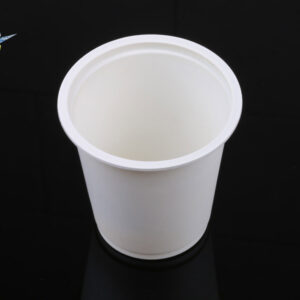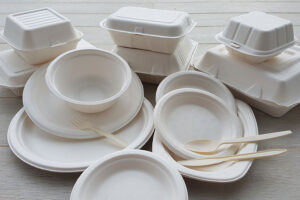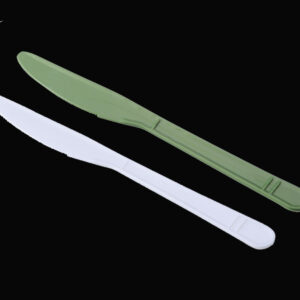Introduction

The shift towards green alternatives for everyday items has become increasingly important in the quest for environmentally friendly solutions. Among these, disposable eco-friendly cutlery has gained significant attention. As custom eco-friendly cutlery manufacturers, we often encounter questions about the best materials for sustainable utensils. In this article, we’ll delve into the differences between CPLA and PSM cutlery, two popular choices in eco-friendly disposable cutlery.
CPLA Cutlery: Composition and Characteristics

CPLA, or crystallized polylactic acid, is a bioplastic derived from renewable resources like corn starch. As manufacturers of disposable eco-friendly cutlery, we recognize CPLA for its unique properties.
What Makes CPLA Stand Out
- Biodegradable and Compostable: CPLA cutlery can be composted in industrial facilities, making it a sustainable choice.
- Heat Resistance: CPLA utensils are known to withstand higher temperatures than traditional PLA, making them suitable for hot foods and drinks.
The Use of CPLA in Disposable Cutlery
- Customizable Options: CPLA can be molded into various shapes and sizes, allowing for custom eco-friendly cutlery designs.
- Durability: CPLA cutlery does not compromise strength and durability despite being biodegradable.
CPLA cutlery represents a step forward in combining convenience with environmental responsibility, a goal central to our mission as eco-friendly disposable cutlery manufacturers.
PSM Cutlery: Composition and Uses

PSM, or Plant Starch Material, is another popular option in the disposable eco-friendly cutlery market. Made from a blend of renewable plant starch and traditional plastic fillers, PSM cutlery is known for its practicality.
Characteristics of PSM Cutlery
- Partially Renewable: While PSM includes renewable plant-based materials, it is not fully biodegradable due to the composition of conventional plastics.
- Sturdy and Functional: PSM cutlery offers a robust and heat-resistant option for various dining needs.
Application in Disposable Utensils
- Versatility: PSM suits various uses, from casual dining to catering services.
- Cost-Effective: Generally, PSM cutlery is more affordable than fully biodegradable alternatives, making it a popular choice for cost-conscious, eco-friendly cutlery manufacturers.
As a manufacturer of disposable eco-friendly cutlery, we strive to balance environmental benefits with practicality and affordability, embodied by PSM cutlery.
Comparing CPLA and PSM Cutlery

When choosing between CPLA and PSM cutlery, it’s essential to understand their key differences and how they align with various environmental and practical considerations.
Biodegradability and Environmental Impact
- CPLA: Offers a higher level of biodegradability and is typically compostable in industrial facilities.
- PSM: While more environmentally friendly than traditional plastics, it’s not fully biodegradable due to its partial plastic content.
Performance and User Experience
- CPLA Cutlery: Known for its heat resistance and strength, it is suitable for various foods.
- PSM Cutlery: Offers a balance of durability and functionality, often preferred for its traditional plastic-like feel.
Cost Considerations
- CPLA: Generally, it is more expensive due to its fully biodegradable nature and the cost of production.
- PSM: More affordable, providing a cost-effective, eco-friendly disposable cutlery option for large-scale usage.
As custom eco-friendly cutlery manufacturers, we help our clients navigate these choices, considering their needs and sustainability goals.
How to Choose the Right Eco-Friendly Cutlery

Selecting the appropriate type of eco-friendly disposable cutlery involves considering various factors, from environmental impact to practical needs.
Assessing Your Needs
- Event Type and Scale: PSM cutlery might be more practical for significant events with budget constraints. For smaller, environmentally-focused gatherings, CPLA is ideal.
- Temperature Requirements: If serving hot food and beverages, CPLA’s heat-resistant properties are beneficial.
Understanding the Environmental Trade-offs
- Compostability: If access to industrial composting is available, CPLA is preferable for its compostable qualities.
- Renewable Material Content: CPLA offers a higher percentage of plant-based materials for those prioritizing using renewable resources.
As a manufacturer of customized eco-friendly cutlery, we aim to provide our clients with all the information needed to make informed decisions that align with their environmental values and practical needs.
Frequently Asked Questions about Eco-Friendly Cutlery
To further assist in making informed choices about eco-friendly cutlery, let’s address some common queries:
What is the Shelf Life of CPLA and PSM Cutlery?
- CPLA and PSM cutlery have a comparable shelf life to traditional plastic cutlery when appropriately stored in a cool, dry place.
Can CPLA and PSM Cutlery be Recycled?
- CPLA cutlery is compostable in industrial facilities but not recyclable. Due to its mixed composition, PSM cutlery is typically not recyclable and should be disposed of as general waste.
Are There Any Allergen Concerns with Plant-Based Cutlery?
- While CPLA and PSM are made from plant-based materials, they are generally considered safe and allergen-free. However, checking with the manufacturer for specific allergen information is always advisable.
Conclusion
In the journey towards more sustainable dining solutions, both CPLA and PSM cutlery offer valuable options. Understanding their differences in terms of environmental impact, functionality, and cost can help consumers and businesses choose the proper disposable eco-friendly cutlery. As customized eco-friendly cutlery manufacturers, we remain committed to innovating and providing a range of options to cater to the diverse needs of our eco-conscious clients. The choice of CPLA or PSM cutlery can significantly contribute to your sustainable lifestyle or business practice.







